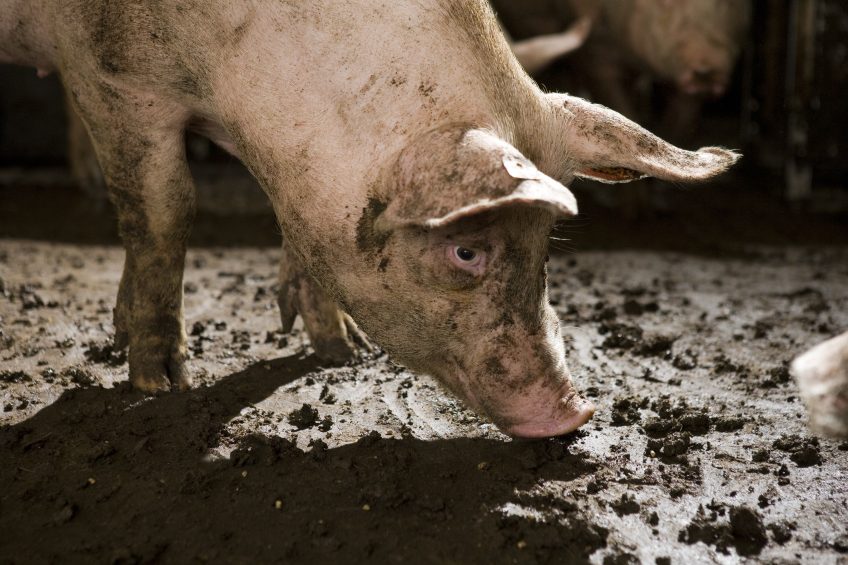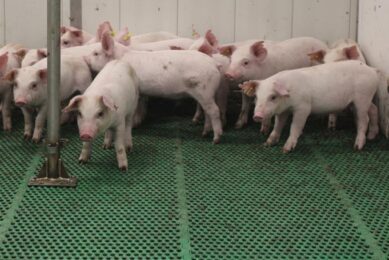Salmonellosis and ileitis – are they linked?

Lawsonia intracellularis and Salmonella Typhimurium: they appear to be two separate gut bacteria. However, as biology reveals itself to always be more complex than theory books, the 2 often reinforce each other’s presence. That means in practice: combat 1, control 2.
Salmonella enterica ser. Typhimurium is responsible for over 1 million cases of food poisoning per year in the USA and is the leading cause of death due to food borne infection. On-going analysis of meat juice at Irish abattoirs indicates that the prevalence of antibodies to the common Salmonella species at pig level is approximately 20%, with a slight reduction in summer months (indicating that one out of every 5 pigs has come into direct contact with a Salmonella bacterium during its lifetime).
Within the abattoir environment the accidental laceration of intestines potentially exposes the carcass and neighbouring carcases to bacteria that are otherwise resident within the gut of a healthy pig. A reduction in the intestinal carriage of Salmonella species would be expected to reduce the incidence of carcase contamination within the abattoir that may occur during the evisceration process. Risk factors associated with salmonellosis in pigs have been demonstrated, including:
- the hygiene on the unit (hand washing, rodent control, bird and fly control, cleaning and disinfection procedures);
- the management of the unit (herd size, batch production, all in/all out, solid pen partitions);
- feeding practices (dry versus wet, pH, particle size);
- other health issues (parasite burden, antibiotic usage, presence of other pathogens).
Demonstrating risk factors
A study was carried out on 105 French pig farms, all farrow to finish, single sites, in order to demonstrate the risk factors associated with pigs that were shedding Salmonella enterica at slaughter age, compared to those that were not. The study included tests to determine whether these pigs had been infected with PRRS virus type 1 or Lawsonia intracellularis (LI), the organism responsible for ileitis in pigs.
Ileitis is very common in pig herds worldwide and presents either as clinical disease (the uncommon, acute presentation of bloody faeces and death, usually in older pigs (Porcine Haemhorragic Enteropathy) or the more common, chronic presentation of mild scour and lack of uniformity in pigs of all ages) or as subclinical disease (where the infection occurs but with limited overt clinical signs of disease, but usually with an impact on production parameters).
A single batch of pigs was followed from birth to slaughter on each farm included in this French study. Faecal and blood samples were collected from selected pigs, and from their environment, during each farm visit (monthly).
Data was also collected regarding:
- the characteristics of the farm (size, pig density, health status, pig flow),
- the biosecurity (hygiene, down time between batches, cleaning and disinfecting procedures between batches, removal of faeces, removal of old feed and water from troughs in between batches),
- feeding practices (dry, wet, home mixed, frequency of feeding etc.).
The faeces samples were used to determine Salmonella species shedding and the blood samples were used to determine prior exposure to either LI or PRRSv.
6 factors were identified as significantly increasing the chances of pigs shedding Salmonella enterica by the end of the finishing period. In order of decreasing risk, these were:
- exposure to LI during the second half of finishing;
- using dry feed during the finishing period;
- contamination of the finishing area with Salmonella species from a previous batch;
- exposure to PRRSv type 1 by the mid/late finishing period;
- once daily or less frequent removal of faeces from behind the sow during the lactation period
- not emptying the pit below the slatted floor in between batches of sows.
These findings confirmed that infection with LI (resulting in either clinical or subclinical ileitis) and PRRSv type 1 were each associated with an increase in shedding of Salmonella enterica at the end of the finishing period.

Selection of articles that delve deeper into several feeding and managements practices regarding gut health and how they can positively influence animal health. Read more…
Ileitis increasing the risk of salmonellosis?
Another research group, based at The Roslin Institute near Edinburgh, recently identified that infection of pigs with Lawsonia intracellularis causes a reduction in activity of the gene responsible for the production of mucins within the gut. Mucins are the main component of the protective mucous layer that lines the gut and have been shown to have direct antimicrobial activity. The study concluded that changes in the gut mucous barrier in pigs associated with Lawsonia intracellularis infection (ileitis) may allow increased invasion of pathogens directly into the cells that line the gut.
The possible practical implications of this interaction were demonstrated by a study looking at the impact of vaccination against Lawsonia intracellularis around weaning on the subsequent shedding of Salmonella species.
Results of the study showed that, following challenge with both Lawsonia intracellularis and Salmonella species, pigs that had been previously orally vaccinated against LI had significantly lower amounts of bacterial shedding and also fewer pigs were shedding, compared to those that had not been vaccinated. Therefore, they concluded that vaccination against LI (to reduce the impact of ileitis on farm) may be a new tool to help improve food safety.
In-feed antibiotics
At farm level, outbreaks of clinical ileitis in grower and finisher pigs are sometimes treated with in-feed antibiotics. The potentially detrimental effects of antibiotic treatment on the pig’s gut microbiota (naturally occurring bacteria within the gut) as manifest by increased shedding of Salmonella species, was explored in a field challenge study.
Pigs were allocated to 2 groups and were either vaccinated, orally, against LI (at three weeks of age) or given a 5-day course of antibiotics. 2 days later, 2 pigs from each group were artificially inoculated with Salmonella derby and once confirmed to be infected and shedding they were then placed back in with their original pen mates. The pattern of shedding for both groups of pen mates was recorded over a 4-week period.
Results showed that the group that had previously been treated with antibiotics had a shedding rate of 43% whereas the vaccinated group had a shedding rate of 3.3%. This represented a statistically significant reduction in infection and shedding rate. The study concluded that treatment with antibiotics had likely altered the gastro-intestinal flora of the pigs and increased their susceptibility to salmonellosis.
In addition, this finding involved a single course of antibiotics, however, on those occasions where multiple courses of antibiotics are undertaken the effect may be exacerbated.
Major cause of food poisoning
Salmonella species are a major cause of food poisoning in people and these are present in pigs in Ireland, as in most countries. There are many complex interactions between the different infectious agents that affect pigs and our understanding of these is increasing all the time. As knowledge improves, control strategies need to adapt to incorporate new insights so that pig health improvement and productivity is possible and, in the case of Salmonella, reduce shedding at farm level.
References available on request. This article was first published in Irish Farmers Monthly.











